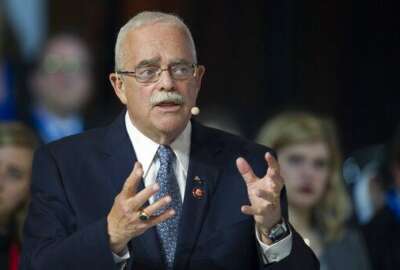OPM has a new tiger team to help agencies wade through federal hiring demands
The agency is also building a new spot on USAJobs.gov for positions related to implementation of the new infrastructure law, and it's pursuing changes to the Pa...
It’s all hands on deck for the agencies trying to staff up and meet the talent demands of a new infrastructure law, as well as the usual hiring needs that come with succession planning.
Internally, the Office of Personnel Management has assembled a tiger team, made up of about 30 people from the agency’s policy, oversight and Human Resources Solutions shops, to focus on those surge federal hiring efforts across government.
“We’ve organized ourselves inside the agency to be able to respond and support the work that’s going to be required for us to fulfill the mission of the Infrastructure Investment and Jobs Act,” OPM Director Kiran Ahuja said Friday during a virtual discussion with the National Academy of Public Administration. “We’re going to be helping agencies align their leadership, survey their respective workforce to identify needs, plan for sourcing and recruiting, integrate hiring flexibilities and streamline their talent search processes.”
Some agencies already had a need to hire more employees before the infrastructure law became a mission requirement, the Biden administration has said, but those needs have become more acute now.
“That means agencies will need to hire thousands of federal employees in a very short period of time,” Ahuja said. “We recognize that this is a once-in-a-generation opportunity to rebuild the federal workforce and bring in the next generation of civil servants.”
OPM sits on the multi-agency task force charged with implementing the new infrastructure law across government, along with the departments of Agriculture, Commerce, Energy, Interior, Labor and Transportation, and the Environmental Protection Agency.
The OPM tiger team will help each of those agencies develop their own talent plans, Ahuja said.
“It’s really a comprehensive look at what’s happening in the agencies, and it’s going to take in real time where they’re already at and the needs they already have, in addition to these offices that they’re having to build out,” she said. “I will also say that we’re looking at positions that are going to need to be filled at all agencies, like HR specialists or grant or contract specialists, efforts that we can do more at a governmentwide level.”
OPM itself has onboarded more than 340 new employees during the last fiscal year, Ahuja said. The agency lost some senior-level expertise in recent years over the uncertainty of the previous administration’s proposed OPM-GSA merger.
“We’re working very hard to ensure that not only we’re in good shape, but we’re in good shape to serve every agency and to make sure they have the tools and the support that they need,” Ahuja said. “One of my top priorities as director is to elevate OPM as a strategic human capital partner for the federal government.”
For OPM, that means creating tools and resources to help agencies be successful with their own hiring. It released a new talent surge playbook and federal hiring authority guide last week, which also detail a handful of recent policies that OPM has finalized within the last year.
Those new policies include a regulation letting agencies rehire former federal employees to positions at a higher grade level than when they left government, as well as three other rules on hiring students, recent graduates and military spouses more easily.
OPM also sent agencies a strategic hiring questionnaire to get a better sense of their workforce needs, Ahuja said.
“The goal is not just to build a federal workforce that meets the challenges for today; it really is about laying out a foundation for a federal government that will allow Americans to strive for decades to come,” she said.
In addition, OPM will launch a dedicated USAJobs.gov landing site where jobseekers can find positions related to the new Infrastructure Investment and Jobs Act.
Ahuja has spoken often about her goals for attracting more early-career talent to government. Those efforts include improving the Pathways internship program, a message that she reiterated Friday and described as a priority headed into 2022.
“We’re going to do a refresh of the Pathways Program and really try to reconnect and reinvigorate our relationships with colleges, trade schools and other learning institutions,” she said. “We’ve been with Pathways for 10 years. I know it’s had its challenges for sure, and so it’s time for us to really evaluate and make some of those improvements. We’re also exploring the feasibility of creating a central internship portal on USAJobs to publicize federal internship and fellowship programs, including those hosted by third parties.”
The Pathways Program was the subject of a new bill that Gerry Connolly (D-Va.), chairman of the House Oversight and Reform Subcommittee on Government Operations, introduced last week. The bill would require OPM create a centralized federal internship portal, but Ahuja didn’t comment directly about the legislation.
The Presidential Management Fellowship, another component of the Pathways Program, has been undergoing some changes. Ahuja said OPM saw a 20% increase in the number of applications for the PMF program this year.
“We’re excited because that’s correlated with a big push we’ve done among agencies to really make sure that those fellows have a place to land,” she said.
At the same time, OPM and the Office of Management and Budget will also stand up a new hiring assessment line of business, a development the Biden administration teased in the president’s budget 2022 request.
“We’ll be doing a big focus on supporting talent teams in agencies, sponsoring innovations in hiring and helping agencies strengthen their hiring assessments effectively, as well as the work we’ll do around surge hiring,” Ahuja said of the new line of business.
Ahuja acknowledged some agencies will need help, particularly in the area of pay, to attract new employees with special skills in a tight labor market.
OPM under the Trump administration wanted to pursue an overhaul of the pay and classification system, efforts that fizzled out when attention over the proposed merger took center stage.
Today, OPM is focused on ensuring agencies know about the tools and special authorities they can use now to pay new talent with special skills.
“It is a longer, larger effort to pursue, which is not to say that we wouldn’t,” Ahuja said of broader pay and classification reform efforts. “But what we are realizing is that oftentimes agencies aren’t using the tools that they have in front in them, which are the special pay rates, recruitment/retention rates, critical pay rates.”
She did tease “a set of fairly bold legislative ideas” on federal hiring, pay and other talent management issues,” which are in the works within OPM internally.
“There’s such positive energy. Not to say that we can’t think pie-in-the-sky, but what’s right in front of us that we can fix and improve in real time?” Ahuja said. “We’re mindful of the time we have and really showing those short-term successes to build on more of the long-term, systematic change that we also long for.”
Copyright © 2024 Federal News Network. All rights reserved. This website is not intended for users located within the European Economic Area.
Nicole Ogrysko is a reporter for Federal News Network focusing on the federal workforce and federal pay and benefits.
Follow @nogryskoWFED
Related Stories
 Exclusive
Exclusive 




